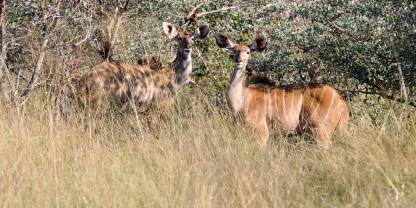Average Expert Rating
Rating Breakdown
Write a User ReviewLike Chobe Was Maybe 20 Years Ago…
Bwabwata is very much an understated park, overshadowed by the country’s big hitters like Etosha and the Skeleton Coast. Part of the Zambezi Region (formerly the Caprivi Strip), it is very different to the rest of Namibia, a vividly lush landscape of rivers and wetlands.
Wildlife here had been decimated through hunting and poaching during Namibia’s struggle for independence, so I wasn’t expecting much, but ended up being totally surprised by what we saw. At a waterhole by Nambwa Lodge, we watched elephants, kudu, waterbuck, reedbuck, impalas and warthogs, while on a plain appropriately called Little Serengeti we came across buffalo, wildebeest, zebra and giraffe.
My favorite place was Horseshoe Lagoon, a beautiful curving expanse of inky-blue water and beach where we watched around 80 elephants coming to the water. A comment by the owner of a nearby camp summed up this park perfectly: “It’s like Chobe in Botswana was maybe 20 years ago,” he told me, “with all the wildlife but none of the crowds.”
Community-Run Tourism Amid Lush River Scenery
Sadly, this part of the Caprivi Strip was badly poached during the Angolan civil war, but recent efforts to rehabilitate the environment seem to be paying off. Elephants are pretty easy to see, waterbucks and tsessebes have been reintroduced and elusive antelopes such as sitatungas, sables and red lechwes are also present.
The park has three conservation zones: Mahango (excellent for birdwatching, with well over 300 species), Buffalo (with large herds of, you guessed it, buffalo) and Kwando (which includes a wildlife-rich stretch of the Kwando River). Elsewhere in the park, land is given over to villages,
Read more
grazing lands and smallholdings. Popa Falls, on the Okavango River at the western edge of the park, is a popular and pleasant spot – but before you get too excited, it’s worth mentioning that these falls are actually rapids; they’re broad, but not high.Bwabwata: The Zambezi Region’s Heartland
Of all the parks in the Zambezi Region (Caprivi Strip; in Namibia’s extreme northeast) that have made a comeback in recent years, it’s Bwabwata that has grown most in stature. Lion sightings are common, African wild dogs frequently pass through, elephants are common, and you’re almost guaranteed to see sable antelope. There’s also some pretty country around here, from the riverine area along the Kwando River where elephants are also almost guaranteed, to the terrific birding along the reedy channels at the park’s eastern fringe. Bwabwata also has a number of zones that take in different habitats and it’s increasingly a hugely significant extension to the wildlife-rich ecosystem and corridors that range all the way from Chobe and the Okavango to Khaudum National Park and beyond to Angola and Zambia.
The New Jewel in Namibia’s Conservation Crown
Sometimes referred to as “the people’s park”, Bwabwata is one of very few places in Africa where humans and animals coexist inside a national park. It’s an ambitious community-driven conservation project that has seen animal populations once decimated by rampant poaching and the so-called Border War of the 70s and 80s, returning in their droves.
The park is particularly well-known for its elephants, and on a recent visit I saw more than 100 in a single game drive. The aptly-named Little Serengeti in the park’s Mayuni Conservancy was bursting with plains game. I wasn’t so lucky with predators, but fresh lion spoor suggested they were around. Meanwhile, a petrol attendant at a local gas station showed me a picture

